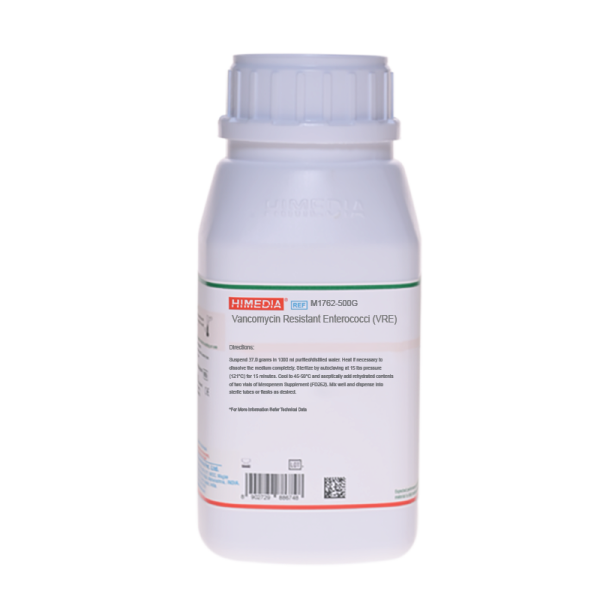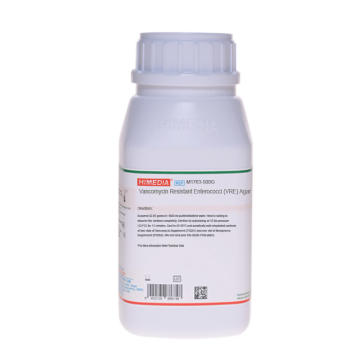 Your enquiry has been submitted
Your enquiry has been submitted
Vancomycin Resistant Enterococci (VRE) Broth Base
Vancomycin Resistant Enterococci#CC293D
Intended Use
Recommended for selective enrichment of Enterococci.
Composition**
| Ingredients | Gms / Litre |
|---|---|
| BHI Powder | 12.500 |
| HI powder | 5.000 |
| Proteose Peptone | 10.000 |
| Dextrose (Glucose) | 2.000 |
| Sodium chloride | 5.000 |
| Disodium hydrogen phosphate | 2.500 |
Final pH ( at 25°C) 7.4±0.2
**Formula adjusted, standardized to suit performance parameters
Directions
Suspend 37.0 grams in 1000 ml purified / distilled water. Heat if necessary to dissolve the medium completely. Sterilize by autoclaving at 15 lbs pressure (121°C) for 15 minutes. Cool to 45-50°C and aseptically add rehydrated contents of 2 vials of Meropenem Supplement (FD262). Mix well and dispense as desired.
Principle And Interpretation
Enterococci usually occur as the normal flora of the intestines of mammal. The presence of enterococci is an indication of faecal contamination (1). The increasing development of multiple resistance towards antibiotics particularly vancomycin by enterococci is a serious threat to the world (2). Vancomycin-resistant Enterococcus (VRE) is the name given to a group of bacterial species of the genus Enterococcus that are resistant to the antibiotic vancomycin. Vancomycin resistanct Enterococci broth is formulated as per the recommendations of Centre for Disease Control and Prevention (CDC) for the enrichment of Enterococcus species including vancomycin resistant enterococci (3). BHI Powder, HI powder and proteose peptone supplies nutrients to the medium. Dextrose serves as an energy source. Sodium chloride maintains the osmotic balance while disodium phosphate buffers the medium. Meropenem Supplement (FD262) added to the medium helps to suppress the contaminating flora especially gram-negative bacteria.
Type of specimen
Clinical samples - faeces
Specimen Collection and Handling
For clinical samples follow appropriate techniques for handling specimens as per established guidelines (4,5). After use, contaminated materials must be sterilized by autoclaving before discarding.
Warning and Precautions
In Vitro diagnostic Use only. For professional use only. Read the label before opening the container. Wear protective gloves/protective clothing/eye protection/ face protection. Follow good microbiological lab practices while handling specimens and culture. Standard precautions as per established guidelines should be followed while handling clinical specimens. Safety guidelines may be referred in individual safety data sheets.
Limitations
- Further biochemical and serological tests must be carried out for further identification.
Performance and Evaluation
Performance of the medium is expected when used as per the direction on the label within the expiry period when stored at recommended temperature.
Quality Control
Appearance Cream to yellow homogeneous free flowing powder
Colour and Clarity of prepared medium Light yellow coloured clear solution without any precipitate.
Reaction Reaction of 3.7% w/v aqueous solution at 25°C. pH : 7.4±0.2
pH 7.20-7.60
Cultural Response Cultural characteristics observed with added Meropenem supplement (FD262), after an incubation at 35-37°C for 18-24 hours.
| Organism | Inoculum (CFU) | Growth |
|---|---|---|
| Escherichia coli ATCC 25922 (00013*) | >=10⁴ | inhibited |
| Pseudomonas aeruginosa ATCC 27853 (00025*) | >=10⁴ | inhibited |
| Salmonella Typhimurium ATCC 14028 (00031*) | >=10⁴ | inhibited |
| Enterococcus faecalis ATCC 29212 (00087*) | >=10⁴ | inhibited |
| Enterococcus faecalis ATCC 51299 ( 00085*) | 50-100 | Good-luxuriant |
Key : *Corresponding WDCM numbers.
Storage and Shelf Life
Store between 10-30°C in a tightly closed container and the prepared medium at 2-8°C. Use before expiry date on the label. On opening, product should be properly stored dry, after tightly capping the bottle in order to prevent lump formation due to the hygroscopic nature of the product. Improper storage of the product may lead to lump formation. Store in dry ventilated area protected from extremes of temperature and sources of ignition. Seal the container tightly after use. Product performance is best if used within stated expiry period.
Disposal
User must ensure safe disposal by autoclaving and/or incineration of used or unusable preparations of this product. Follow established laboratory procedures in disposing of infectious materials and material that comes into contact with clinical sample must be decontaminated and disposed of in accordance with current laboratory techniques (4,5).
Reference
- Mascini EM, Bonten MJ : Vancomycin- resistant enterococci : consequences for therapy and infection control. Clin Microbiol Infect.2005,11 (Suppl.4) :43-56.
- Mara D., Horan NJ : The Handbook of water, wastewater and microbiology, Amsterdam, The Netherlands, Academic Press ; 2003.
- CDC Preventing the spread of vancomycin resistance: a report from the Hospital Infection Control Practices Advisory Committee(1994). Fed Regist. May17.
- Isenberg, H.D. Clinical Microbiology Procedures Handbook 2nd Edition.
- Jorgensen, J.H., Pfaller, M.A., Carroll, K.C., Funke, G., Landry, M.L., Richter, S.S and Warnock., D.W. (2015) Manual of Clinical Microbiology, 11th Edition. Vol. 1.
| Product Name | Vancomycin Resistant Enterococci (VRE) Broth Base |
|---|---|
| SKU | M1762 |
| Product Type | Regular |
| Physical Form | Powder |
| Origin | Animal |
| Packaging type | HDPE |
| References | 1.Mara D., Horan NJ : The Handbook of water, wastewater and microbiology , Amsterdam, The Netherlands , Academic Press ;2003.2.Mascini EM, Bonten MJ : Vancomycin- resistant enterococci : consequences for therapy and infection control . ClinMicrobiol Infect.2005,11 (Suppl.4) :43-563.CDC Preventing the spread of vancomycin resistance: a report from the Hospital Infection Control Practices AdvisoryCommittee (1994). Fed Regist. May17. |
| Customized Product Available | No |






